|
UFO Files: Pacific
Bermuda Triangle

The History
Channel’s excellent series, UFO Files, keeps on going from
strength to strength. If they ever release a DVD box set of the
series, not only will it be huge, but it will be a required purchase
for anybody interested in this subject.
I digress,
though. One of the latest episodes was entitled Pacific Bermuda
Triangle and concerned itself with an area of the Pacific Ocean
known as the Dragon’s Sea, Devil’s Sea or the Dragon’s Triangle.
This is an area, on the opposite side of the world to the North
Atlantic’s Bermuda Triangle, where ships and boats have vanished
without a trace and numerous strange sightings have occurred for
many, many years.

Covering an
area of about half a million square miles, the Dragon’s Triangle is
located south of the islands of Japan, reaches down to the isle of
Guam and across to the island nation of Palau, east of the
Philippines. Curiously, the northern tips of both the Dragon’s
Triangle and the Bermuda Triangle lie close to the latitude of 35°
north.
 Bill
Birnes, publisher of UFO Magazine, claims that the magnetic
anomalies within both of these triangles disrupt compass readings by
about twenty degrees. Bill
Birnes, publisher of UFO Magazine, claims that the magnetic
anomalies within both of these triangles disrupt compass readings by
about twenty degrees.
Despite
being less well-known than its western counterpart, the Dragon’s
Triangle appears to have a more deadly history, with vessels
disappearing on a far more regular basis. Since World War II, it has
been estimated that over 1,500 vessels and hundreds of aircraft have
vanished here.
 The
region gained notoriety after the publication of The Dragon’s
Triangle by Charles Berlitz in 1989. Berlitz had brought the
Bermuda Triangle to worldwide attention fifteen years previously
with his best-selling book. For his 1989 book, Berlitz researched
hundreds of disappearances and strange events in the Dragon’s Sea,
citing ghost ships, compass fluctuations, UFO sightings and ships
being transported hundreds of miles in seconds. The
region gained notoriety after the publication of The Dragon’s
Triangle by Charles Berlitz in 1989. Berlitz had brought the
Bermuda Triangle to worldwide attention fifteen years previously
with his best-selling book. For his 1989 book, Berlitz researched
hundreds of disappearances and strange events in the Dragon’s Sea,
citing ghost ships, compass fluctuations, UFO sightings and ships
being transported hundreds of miles in seconds.
 On
the second of July, 1937, famed aviator, Amelia Earhart and her
co-pilot, Fred Noonan, took off from Lae in Papua New Guinea. Their
goal was Howland Island, some two and a half thousand miles distant.
Barely eight hundred miles into the flight and with no warning, her
plane vanished. Many explanations have been proffered for Earhart’s
and Noonan’s disappearance, ranging from navigational error
resulting in the plane running out of fuel and ditching into the
ocean, to the pair being captured by Japanese soldiers and possibly
killed or imprisoned for espionage, to abduction by UFOs. Whatever
the cause of Earhart’s loss, hers is one of the most famous stories
linked to the Dragon’s Triangle. On
the second of July, 1937, famed aviator, Amelia Earhart and her
co-pilot, Fred Noonan, took off from Lae in Papua New Guinea. Their
goal was Howland Island, some two and a half thousand miles distant.
Barely eight hundred miles into the flight and with no warning, her
plane vanished. Many explanations have been proffered for Earhart’s
and Noonan’s disappearance, ranging from navigational error
resulting in the plane running out of fuel and ditching into the
ocean, to the pair being captured by Japanese soldiers and possibly
killed or imprisoned for espionage, to abduction by UFOs. Whatever
the cause of Earhart’s loss, hers is one of the most famous stories
linked to the Dragon’s Triangle.
Another
aspect of the mystery of the triangle is that of ghost ships. For
centuries, stories have abounded of cursed vessels sailing without
crews and the stories continue to this day. Ghost ships exceeding a
hundred thousand tons have been reported. What happened to their
crews is a complete mystery.
On the
morning of June 11th, 1881, a British warship, HMS
Bacchante, encountered the legendary Flying Dutchman,
deep within the Dragon’s Triangle. A young ensign, who would later
be crowned King George V, reported in the ship’s log:
“The
Flying Dutchman crossed our bows. She emitted a strange,
phosphorescent light as of a phantom ship, all aglow. She came up on
the port bow, where also the officer of the watch from the bridge
saw her. But on arriving, there was no vestige or any sign whatever
of any material ship to be seen, either near of right away to the
horizon, the night being clear and the sea calm.”
In January,
1989, a Japanese whaling ship came within fifty feet of a small
fishing boat. The boat was boarded, but no crew or cargo could be
found. All that was found was the corpse of the captain, his hands
still gripping the helm.
Bill Birnes
suggests that these missing crews may have been abducted by aliens,
snatched from their vessels by a USO or Unidentified Submerged
Object.
Of course,
entire vessels have vanished without a trace, taking their
unfortunate personnel with them.
In April,
1949, the Kuroshio Maru No. 1, a Japanese ship with
twenty-three people on board, disappeared. In June 1952, the
Chofuku Maru No. 5 vanished with all twenty-nine hands. On 26th
June, 1955, a US Air Force F-3B jet lost contact with its base and
the plane was never heard from again. In March, 1957, a KB-50 tanker
aircraft with eight crewmen aboard vanished. June 7th,
1963, and what was left of the Donan Maru was found adrift.
 The
Kaiyo Maru No. 5 was a Japanese survey ship researching the
area for the Hydrographic Department of the Maritime Safety Agency.
On September 24th, 1952, the ship was lost with all
thirty-one crew, making it the biggest disaster in the history of
Japanese oceanographic research. The favoured explanation for the
complete loss of the ship is that it was caught by the blast from a
submerged volcano (the Triangle has many volcanoes, as it lies
within the Pacific ‘Ring of Fire’), some are not convinced, claiming
that the Kaiyo Maru was a victim of the Dragon’s Triangle. The
Kaiyo Maru No. 5 was a Japanese survey ship researching the
area for the Hydrographic Department of the Maritime Safety Agency.
On September 24th, 1952, the ship was lost with all
thirty-one crew, making it the biggest disaster in the history of
Japanese oceanographic research. The favoured explanation for the
complete loss of the ship is that it was caught by the blast from a
submerged volcano (the Triangle has many volcanoes, as it lies
within the Pacific ‘Ring of Fire’), some are not convinced, claiming
that the Kaiyo Maru was a victim of the Dragon’s Triangle.
Like the
Bermuda Triangle, the Dragon’s Sea is said to be an area in which
the rules of time and space are in flux, causing ships and planes to
be forced off course by many miles in an instant. Loren Coleman,
author of Mysterious America, says that there are many
explanations, but it really is a mystery why these temporal effects
occur.
 In
the late 1950s, American entertainer, Arthur Godfrey, was flying
over the Dragon’s Triangle when his instruments failed and he saw a
USO. Flying blind for an hour before his instruments returned to
life, he made it to Tokyo and found that he had ‘lost’ thirty
minutes. In
the late 1950s, American entertainer, Arthur Godfrey, was flying
over the Dragon’s Triangle when his instruments failed and he saw a
USO. Flying blind for an hour before his instruments returned to
life, he made it to Tokyo and found that he had ‘lost’ thirty
minutes.
Lieutenant
Colonel Frank Hopkins, an advisor to the 106th Air
Transport Group, was flying in a C-97 Stratofreighter over the
triangle in 1968. Back then, he was a navigator and, as protocol
required, he used star navigation to plot their course every hour.
Three hours into the flight, he took another celestial fix and was
astonished to find that their position was more than 340 nautical
miles down their intended course. On landing, he told his duty
officer that the aircraft had been ‘dropped’ many hundreds of miles
ahead of their plotted course. No report was filed. Hopkins
maintained that the area was prone to peculiar forces that posed
danger to planes and ships that ventured across it.
Over the
years, there have been huge numbers of UFO and USO reports from
within the Dragon’s Triangle. In Berlitz’s book, he tells of
Mikakunin Hiko-Buttai, the Japanese for UFOs, which have sunk ships
whilst leaving or entering the ocean. In bygone days, these losses
were attributed to demons or dragons that lurked beneath the waves.
Nowadays, Japanese researchers blame USOs or UFOs.
Some
experts believe that part of the Dragon’s Triangle includes the city
of Tokyo in its boundaries. Junichiro Kato, head of OUR-J, the
Organisation of UFO Research – Japan, has photographed over two
hundred objects over the Dragon’s Triangle. He claims to have being
witnessing one or two a month at one point.
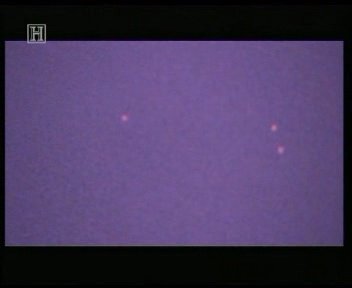 On
June 14th, 1997, Kato photographed what appeared to be
three glowing discs, travelling at over five hundred miles per hour
over Tokyo Bay. The event was witnessed by ten other people and the
news media were alerted, but no reports made it to air. On
June 14th, 1997, Kato photographed what appeared to be
three glowing discs, travelling at over five hundred miles per hour
over Tokyo Bay. The event was witnessed by ten other people and the
news media were alerted, but no reports made it to air.
In 1990, on
a quiet beach about thirty miles south of Tokyo, magazine editor,
Masanobu Miyoshi, witnessed a white light ‘buzzing’ a jet that was
flying over the ocean. He describes the UFO as moving like it was
writing a ‘W’ in the sky. Before his sighting, he did not believe in
UFOs, but what he saw has changed his opinion.
The former
Soviet Union had one of the largest active fleets in the Pacific and
many UFO and USO reports were filed. According to famed Russian
researcher, Vladimir Ajaja, in 1977, the Soviet Navy ordered a study
to be begun to examine reports of unidentified objects seen at sea.
He was in charge of that group and, by the end of that year,
instructions had been given to Soviet naval vessels about how to
observe UFOs and what to do when one was spotted.
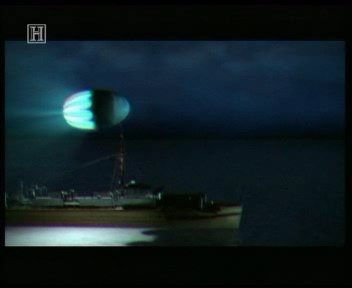 On
August 18th, 1980, the Soviet research ship, the
Vladimir Volbirov was moving south through the Dragon’s Sea on a
course towards the Japanese island of Okinawa. At about midnight, a
glowing, cylindrical object rose from the sea, hovered for a while
and then shot off across the sky. On
August 18th, 1980, the Soviet research ship, the
Vladimir Volbirov was moving south through the Dragon’s Sea on a
course towards the Japanese island of Okinawa. At about midnight, a
glowing, cylindrical object rose from the sea, hovered for a while
and then shot off across the sky.
In April,
1981, the 165-foot Japanese freighter, Taki Kyoto Maru, was
in almost the exact location of the Vladimir Volbirov.
Suddenly the ship was rocked by shockwaves erupting from the sea. A
bright, saucer-shaped object rose out of the
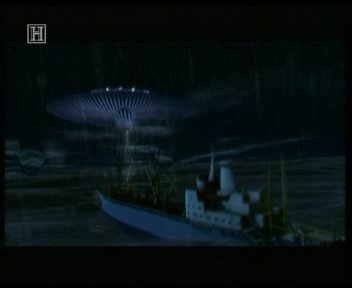 water
and hovered, silently, over the ship. It was about fifty feet in
diameter. The ship’s instruments fluctuated wildly as the saucer
circled the ship for about fifteen minutes. Then it plunged back
into the ocean, again creating huge waves that buffeted the Japanese
vessel, almost causing it to capsize. When their instruments
returned to normal, the captain found that they had lost fifteen
minutes of time. water
and hovered, silently, over the ship. It was about fifty feet in
diameter. The ship’s instruments fluctuated wildly as the saucer
circled the ship for about fifteen minutes. Then it plunged back
into the ocean, again creating huge waves that buffeted the Japanese
vessel, almost causing it to capsize. When their instruments
returned to normal, the captain found that they had lost fifteen
minutes of time.
In December
of 1984, the Japanese research ship, Kaiyo Maru (obviously
not the same as the one that disappeared in 1952), was off the
Falkland Islands in the South Atlantic. A crewman, Mr Naganobu, saw
two dozen UFOs, hovering in the sky. Suddenly, they shot off in
three different directions. Two years later, the ship was in the
Dragon’s Triangle. A huge, cigar-shaped UFO, over a hundred feet in
length, approached the ship and plunged into the ocean. This event
was once again witnessed by Mr Naganobu. This time, the UFO was also
seen on radar. Both of Naganobu’s reports were published in a 1988,
Japanese edition of Scientific American.
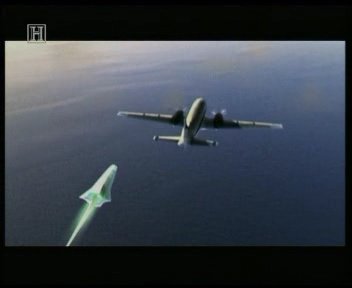 On
March 18th, 1965, the captain of a Toa Airways Convair
passenger plane encountered a large, oblong-shaped craft. To avoid a
collision, he turned his aircraft sixty degrees at over five hundred
miles per hour (the programme shows a twin-prop aircraft, likely a
Convair 240, so it is unlikely that a speed of 500 mph was achieved.
The passenger plane may have been a Convair jetliner that can
fly over that speed and were in service in 1965, such as the Convair
990). The UFO stopped suddenly and then manoeuvred alongside the
airliner. The captain radioed that he was being ‘shadowed by a UFO’. On
March 18th, 1965, the captain of a Toa Airways Convair
passenger plane encountered a large, oblong-shaped craft. To avoid a
collision, he turned his aircraft sixty degrees at over five hundred
miles per hour (the programme shows a twin-prop aircraft, likely a
Convair 240, so it is unlikely that a speed of 500 mph was achieved.
The passenger plane may have been a Convair jetliner that can
fly over that speed and were in service in 1965, such as the Convair
990). The UFO stopped suddenly and then manoeuvred alongside the
airliner. The captain radioed that he was being ‘shadowed by a UFO’.
The object
was about fifty feet long and glowed with a greenish hue. The
encounter was witnessed from the ground and another pilot in a
separate aircraft heard the Toa captain’s frantic radio
transmissions.
The object
was independently spotted several times that night at different
locations.
Stories
from the Dragon’s Triangle stretch back hundreds of years, with
tales of sea dragons pulling ships to their doom. The region is also
home to one of the oldest UFO stories:
One day, a
spherical boat was towed into a Japanese village after it appeared
on the beach. Inside was a woman who looked nothing like the locals:
she had white skin, red and white hair, spoke a strange language and
held a box close to her at all times. The ‘boat’ has strange symbols
upon it, like nothing the local people had ever seen.
 Dr
Kazuo Tanaka of Gifu University studied the old stories about this
‘alien woman’ and her craft and came to the conclusion that she was
extra-terrestrial. The story of the Utsuro-fune (or Utsuro-bune)
appeared several times in 19th Century Japanese
literature and many depictions of the woman and her craft were
printed, all very similar. The stories, though set in about 1803,
may date back much further and be drawn from Japanese folklore. It
has been suggested, however, that the woman may have been British,
or at least European, and that the ‘unknown writings’ on her craft
may have been Latin alphabetical characters. Dr
Kazuo Tanaka of Gifu University studied the old stories about this
‘alien woman’ and her craft and came to the conclusion that she was
extra-terrestrial. The story of the Utsuro-fune (or Utsuro-bune)
appeared several times in 19th Century Japanese
literature and many depictions of the woman and her craft were
printed, all very similar. The stories, though set in about 1803,
may date back much further and be drawn from Japanese folklore. It
has been suggested, however, that the woman may have been British,
or at least European, and that the ‘unknown writings’ on her craft
may have been Latin alphabetical characters.
On the 24th
of September, 1235, strange lights were seen to hover over an army
camp in Kyoto. The troops were terrified, thinking the lights were
sea dragons coming to attack them.
In 1274,
Kublai Khan, the Mongol Emperor, amassed a fleet of nine hundred
ships, holding over forty thousand men, and set sail to conquer
Japan. A typhoon formed and more than half of the ships were sunk.
Not to be deterred, Khan assembled over three thousand ships in 1281
and a hundred and forty thousand men and gave his invasion of Japan
another go.
This time,
a ‘divine wind’ destroyed most of the ships and half of the men lost
their lives. This gave rise to the notion that Japan was protected
by the gods and any invasion of her shores was doomed to failure.
 July
8th, 1853, and Commodore Matthew Perry was in Tokyo Bay
at 4am. In his log, he described ‘a remarkable meteor’ that
illuminated the entire area with a blue light. It flew from
south-west to north-east before gradually sinking into the ocean and
disappearing. It was described as a large, blue sphere, with a red,
wedge-shaped tail. The tail appeared ‘like the sparks of a rocket’. July
8th, 1853, and Commodore Matthew Perry was in Tokyo Bay
at 4am. In his log, he described ‘a remarkable meteor’ that
illuminated the entire area with a blue light. It flew from
south-west to north-east before gradually sinking into the ocean and
disappearing. It was described as a large, blue sphere, with a red,
wedge-shaped tail. The tail appeared ‘like the sparks of a rocket’.
American
researcher, Steven Greer, notes that because the Dragon’s Triangle
is located in the Pacific Ring of Fire, a highly active area of
volcanism, many UFO sightings in the region will be because of the
tectonic activity deep below the sea.
US Navy
ships have detailed charts showing where the known areas of activity
are located and ships are advised to stay away from those regions.
Dr Joann Stock, of the California Institute of Technology (CalTech),
explains that when undersea volcanoes erupt, huge amounts of gases
are released. A ship above such an eruption of gases will find that
it is no longer buoyant, as the bubbles of gas disrupt the water
volume. When this occurs, a ship can be pulled under the surface
very quickly. These submarine eruptions can also release large
amounts of particulate matter that can clog the intakes of aircraft,
causing them to drop of out the sky.
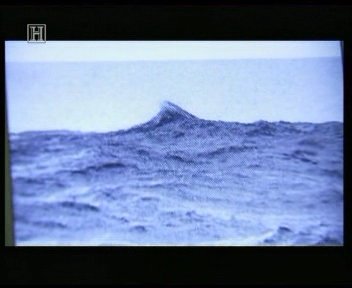 The
Dragon’s Sea is also prone to a phenomenon known as ‘triangle
waves’. These are when winds converge from different directions and
can create a powerful wave many tens of feet high. There have been
reports of triangle waves of a hundred feet or more. The
Dragon’s Sea is also prone to a phenomenon known as ‘triangle
waves’. These are when winds converge from different directions and
can create a powerful wave many tens of feet high. There have been
reports of triangle waves of a hundred feet or more.
Whatever
the reasons for the incidents in the Dragon’s Triangle, and they are
likely to be varied, we have to remember that what happens there is
real. Planes and ships are destroyed and people lose their lives in
that vast expanse of ocean. It is not something that can be simply
dismissed with a shrug of ‘I don’t believe it’. The evidence is
there, mysterious things happen.
Pacific
Bermuda Triangle
was yet another excellent episode from the UFO Files series.
As usual with this programme, every avenue was explored and both
sides of the argument were given time to put their views across. It
was also nice to have an episode that wasn’t called
Northallerton’s Roswell, or whatever. Saying that, we’ll
probably get The Indian Ocean Bermuda Triangle, The Sahara
Bermuda Triangle and The Milton Keynes Bermuda Triangle
before very long.
As I said
at the beginning of this article, if a DVD set was released, it
should be at the top of the list of everybody who has even the
slightest interest in UFOs. Maybe it is out on DVD already and I’ve
missed it!
The images
used are the property of the copyright holders and are only used
here for review purposes.
© Steve
Johnson - 2006 |